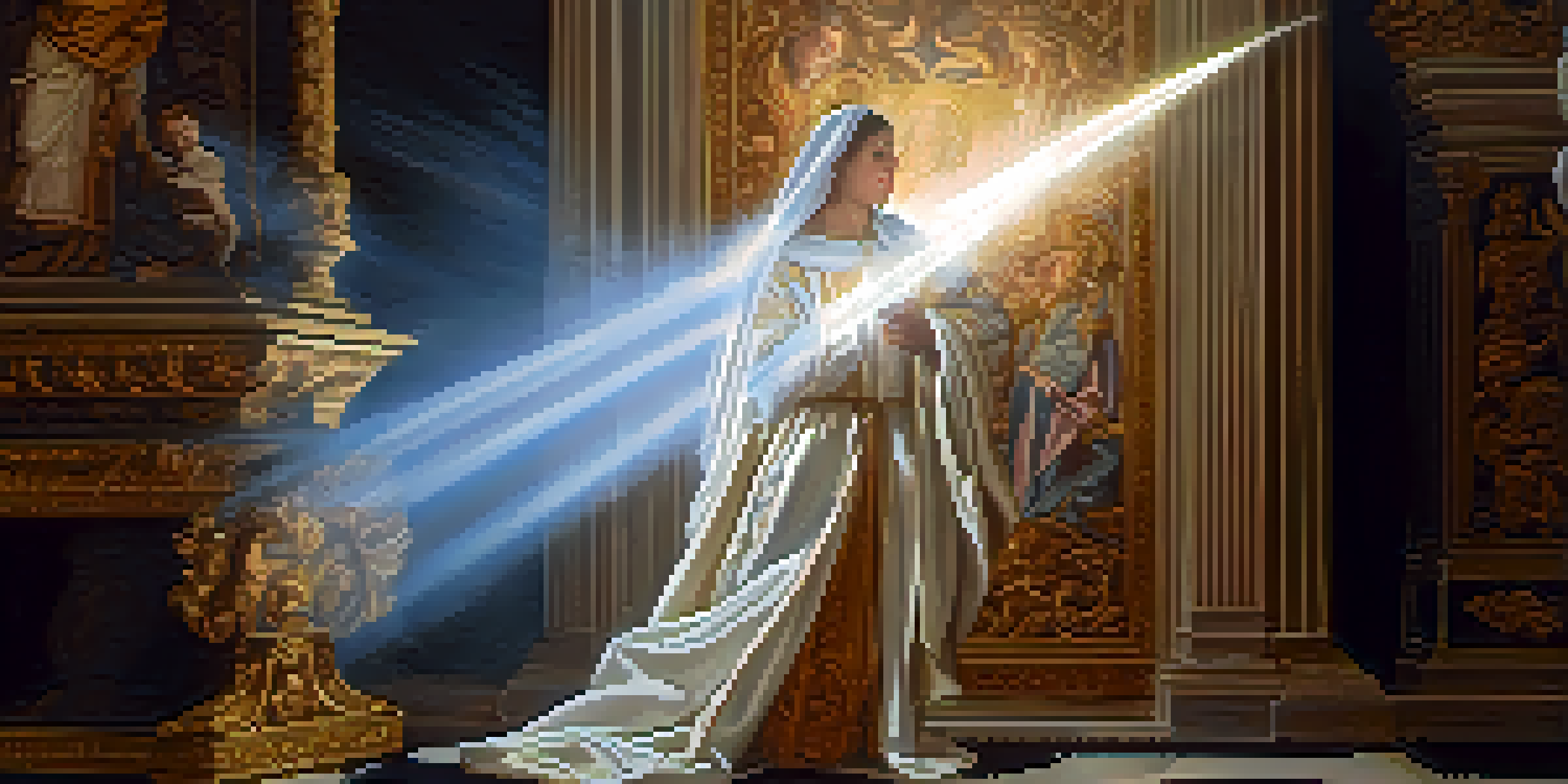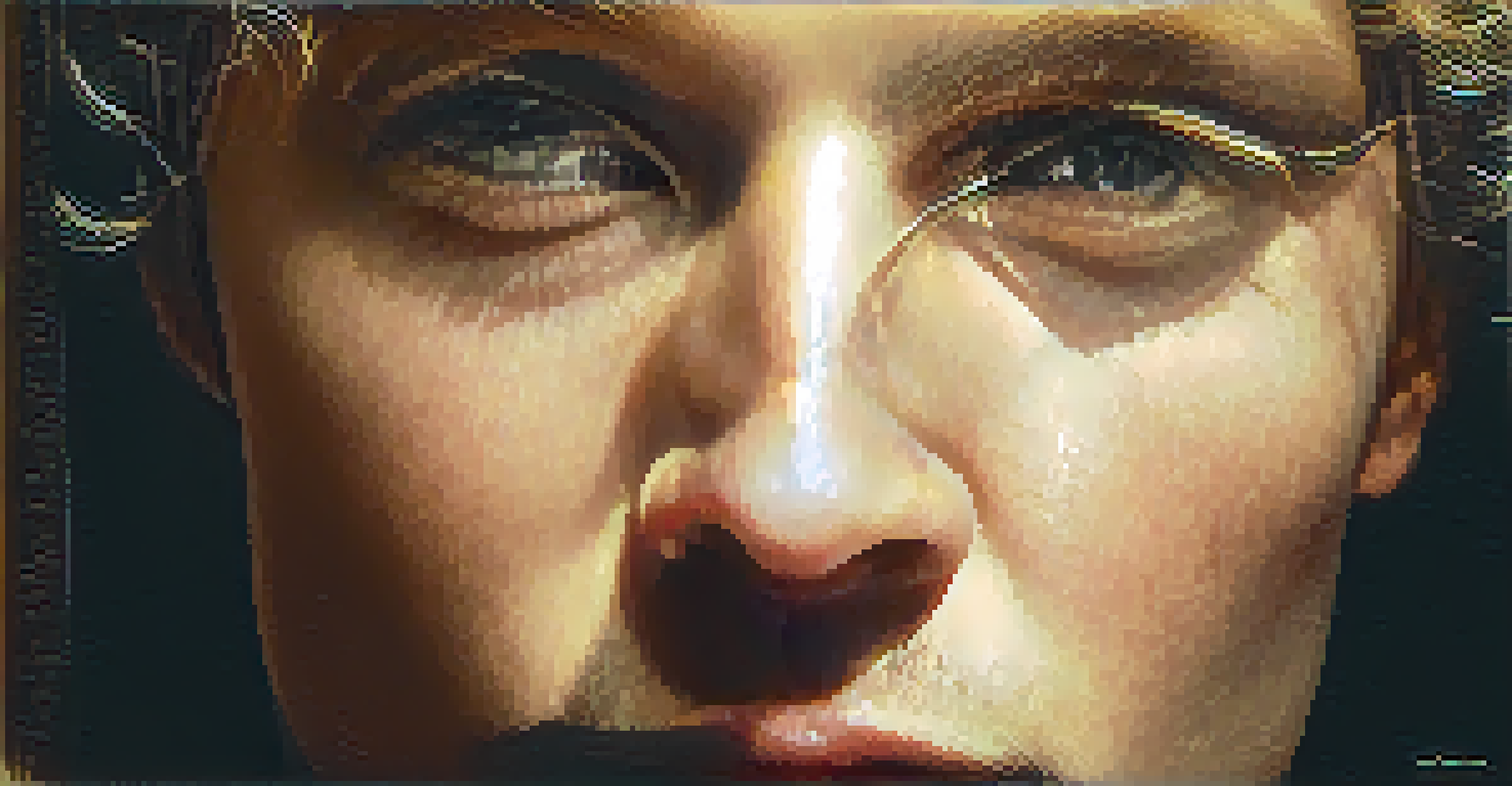Symbolism of Light and Shadow in Baroque Paintings

Understanding Baroque Art's Emphasis on Light and Shadow
Baroque art, flourishing from the late 16th to the early 18th century, is characterized by its dramatic use of light and shadow. This technique, known as chiaroscuro, creates a stark contrast that brings depth and emotion to the artwork. Artists like Caravaggio and Rembrandt mastered this approach, using it to highlight specific elements and guide the viewer's eye. The interplay between light and shadow not only enhances the visual appeal but also serves a symbolic purpose.
Light is the symbol of truth; darkness is the symbol of ignorance.
In Baroque paintings, light often symbolizes divinity, truth, and knowledge, while shadow can represent darkness, ignorance, or sin. This duality reflects the era's complex relationship with religion and morality, as artists sought to evoke profound emotional responses from their audiences. The strategic placement of light can transform a mundane scene into a powerful narrative, inviting viewers to explore deeper meanings.
For instance, in Caravaggio's 'The Calling of Saint Matthew,' the beam of light that illuminates Matthew signifies his divine calling, contrasting with the surrounding darkness. This not only emphasizes the moment of revelation but also symbolizes the struggle between faith and doubt. Such symbolism is pivotal in understanding Baroque art's multifaceted nature.
The Role of Chiaroscuro in Evoking Emotion
Chiaroscuro is not just a technique; it's a powerful tool for evoking emotion in Baroque paintings. By manipulating light and shadow, artists can create dramatic scenes that resonate on a personal level with viewers. For example, the stark contrasts in Rembrandt’s portraits often capture the vulnerability and humanity of his subjects, leading to a deeper emotional connection.

The emotional weight conveyed through chiaroscuro can also enhance storytelling within a painting. By highlighting certain figures while casting others into shadow, artists can guide the audience's focus and create a narrative dynamic. This technique compels viewers to engage with the artwork, provoking thought and reflection about the human experience.
Chiaroscuro: Depth and Emotion
The technique of chiaroscuro in Baroque art creates dramatic contrasts of light and shadow that enhance emotional depth and narrative complexity.
Moreover, the emotional impact of light and shadow can mirror the internal struggles of the characters portrayed. In works like 'The Night Watch,' the interplay of light and shadow not only showcases the subjects’ physical presence but also hints at their psychological depths. This nuanced portrayal emphasizes the complexity of human emotion and experience.
Symbolism of Light in Religious Contexts
In the context of Baroque art, light often carries significant religious symbolism. It is frequently associated with the divine, representing God's presence, holiness, and enlightenment. This connection is especially evident in religious paintings where light is used to highlight Christ or saints, reinforcing their sanctity and importance.
Art is the most beautiful of all lies.
Artists often depicted heavenly light breaking through darkness to symbolize divine intervention or revelation. For instance, in paintings such as 'The Transfiguration' by Raphael, the radiant light surrounding Christ serves to signify his divine nature and the transformative power of faith. This use of light communicates not just beauty but also a profound spiritual message.
The representation of light in religious scenes invites viewers to contemplate their own beliefs and spirituality. By immersing audiences in these luminous moments, artists encourage a deeper understanding of faith and the divine. This interplay of light and shadow thus becomes a vital aspect of the overall narrative, enhancing the viewer's spiritual experience.
The Significance of Shadow in Baroque Imagery
While light is often celebrated, shadow plays an equally important role in Baroque paintings. Shadows can symbolize sin, ignorance, or the human condition, providing a stark contrast to the illuminating light. This duality creates a tension that underscores the moral complexities present in many Baroque narratives.
By incorporating shadow into their compositions, artists can evoke feelings of unease or contemplation. For example, in 'Judith Beheading Holofernes' by Artemisia Gentileschi, the dramatic shadows surrounding the scene amplify the violence and intensity of the moment. Here, shadows not only create depth but also enhance the emotional gravity of the subject matter.
Symbolism of Light and Shadow
Light often symbolizes divinity and truth, while shadow represents darkness and sin, reflecting the era's intricate moral and spiritual themes.
Moreover, shadows can serve as a reminder of humanity's flaws and struggles. They represent the darker aspects of life, prompting viewers to confront uncomfortable truths. This exploration of shadow allows Baroque artists to delve into the complexities of human nature, making their work even more impactful.
Light and Shadow as Metaphors for Good and Evil
In Baroque art, light and shadow frequently symbolize the eternal struggle between good and evil. This metaphorical representation can be seen in various works where light illuminates virtuous characters while casting others in darkness. This visual dichotomy serves to reinforce moral narratives, guiding viewers to discern right from wrong.
For instance, in 'The Supper at Emmaus' by Caravaggio, the figure of Christ is bathed in light, signifying his divine nature and truth, while the surrounding figures remain in shadow. This contrast not only emphasizes Christ's role as the savior but also highlights the uncertainty and disbelief of humanity. Such symbolic use of light and shadow invites viewers to reflect on their own moral choices.
This interplay between light and shadow also mirrors the complexities of human nature, suggesting that everyone harbors both good and evil within them. By exploring these themes, Baroque artists engage their audiences in a dialogue about morality, faith, and the human condition, making their work timeless and relevant.
The Influence of Baroque Techniques on Modern Art
The techniques of light and shadow that flourished during the Baroque period have significantly influenced modern art. Contemporary artists continue to explore chiaroscuro, using it to evoke emotion and create depth in their works. This enduring legacy showcases the timelessness of Baroque principles, proving their relevance in today’s artistic expressions.
Many modern painters incorporate similar contrasts to convey complex narratives and emotions. By referencing Baroque techniques, they pay homage to the past while also innovating new ideas. This fusion of old and new creates a rich tapestry of artistic exploration, allowing for fresh interpretations of familiar themes.
Legacy of Baroque Techniques
Baroque techniques of light and shadow continue to influence modern art, showcasing their timeless relevance in conveying complex narratives.
Additionally, the symbolism of light and shadow remains a powerful tool in storytelling across various media, including film and digital art. The influence of Baroque art can be seen in how modern artists utilize these elements to craft compelling visuals that resonate with audiences. This connection underscores the lasting impact of the Baroque period on the evolution of artistic expression.
Conclusion: The Enduring Legacy of Light and Shadow
The symbolism of light and shadow in Baroque paintings offers a profound insight into the human experience. Through chiaroscuro, artists create emotional depth and convey complex narratives that resonate with viewers. This dynamic interplay not only beautifies the artwork but also invites contemplation about morality, spirituality, and human nature.
As we analyze these masterpieces, we find that the themes of light and shadow remain relevant today. They challenge us to reflect on our own beliefs and experiences, illustrating the timelessness of Baroque art's messages. The emotional and symbolic weight of these elements continues to inspire artists and audiences alike.

Ultimately, the legacy of light and shadow in Baroque paintings endures, reminding us of the power of art to evoke emotion, provoke thought, and connect us to our shared humanity. This exploration of contrasts enriches our understanding of both the artwork and ourselves, making the study of Baroque symbolism a journey worth undertaking.